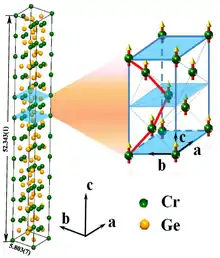

In inorganic chemistry, a Nowotny chimney ladder phase (NCL phase) is a particular intermetallic crystal structure found with certain binary compounds. NLC phases are generally tetragonal and are composed of two separate sublattices. The first is a tetragonal array of transition metal atoms, generally from group 4 through group 9 of the periodic table. Contained within this array of transition metal atoms is a second network of main group atoms, typically from group 13 (boron group) or group 14 (carbon group). The transition metal atoms form a chimney with helical zigzag chain. The main-group elements form a ladder spiraling inside the transition metal helix.
The phase is named after one of the early investigators H. Nowotny.[1][2][3] Examples are RuGa2, Mn4Si7, Ru2Ge3, Ir3Ga5, Ir4Ge5 V17Ge31, Cr11Ge19, Mn11Si19, Mn15Si26, Mo9Ge16, Mo13Ge23, Rh10Ga17, and Rh17Ge22.[4]
In RuGa2 the ruthenium atoms in the chimney are separated by 329 pm. The gallium atoms spiral around the Ru chimney with a Ga–Ga intrahelix distance of 257 pm. The view perpendicular to the chimney axis is that of a hexagonal lattice with gallium atoms occupying the vertices and ruthenium atoms occupying the center. Each gallium atom bonds to 5 other gallium atoms forming a distorted trigonal bipyramid. The gallium atoms carry a positive charge and the ruthenium atoms have a formal charge of −2 (filled 4d shell).[5]
In Ru2Sn3 the ruthenium atoms spiral around the tin inner helix. In two dimension the Ru atoms form a tetragonal lattice with the tin atoms appearing as triangular units in the Ru channels.[6]
The occurrence of a LCP phase can be predicted by the so-called 14 electron rule. In it the total number of valence electrons per transition metal atom is 14.[7][8][9]
References
- ↑ Schwomma, O.; Preisinger, A.; Nowotny, H.; Wittmann, A. (1964). "Die Kristallstruktur von Mn11Si19 und deren Zusammenhang mit Disilicid-Typen". Monatshefte für Chemie und Verwandte Teile Anderer Wissenschaften. 95 (6): 1527–1537. doi:10.1007/BF00901708.
- ↑ Schwomma, O.; Nowotny, H.; Wittmann, A. (1964). "Untersuchungen im System: Ru−Sn". Monatshefte für Chemie und Verwandte Teile Anderer Wissenschaften. 95 (6): 1538–1543. doi:10.1007/BF00901709.
- ↑ Völlenkle, H.; Wittmann, A.; Nowotny, H. (1964). "Untersuchungen an Germaniden der Übergangsmetalle V, Cr, Mo und Mn". Monatshefte für Chemie und Verwandte Teile Anderer Wissenschaften. 95 (6): 1544–1549. doi:10.1007/BF00901710.
- ↑ Lu, Guoxin; Lee, Stephen; Lin, Jianhua; You, Liping; Sun, Junliang; Schmidt, Joshua Teal (2002). "RuGavSnw Nowotny Chimney Ladder Phases and the 14-Electron Rule". Journal of Solid State Chemistry. 164 (2): 210–219. Bibcode:2002JSSCh.164..210L. doi:10.1006/jssc.2001.9462.
- ↑ King, R. Bruce (2007). "The Relationship between the Nowotny Chimney Ladder". Revista de Chimie. 58 (5): 439–441.
- ↑ Fredrickson, Daniel C.; Lee, Stephen; Hoffmann, Roald; Lin, Jianhua (2004). "The Nowotny Chimney Ladder Phases: Following thecpseudo Clue toward an Explanation of the 14 Electron Rule". Inorganic Chemistry. 43 (20): 6151–6158. doi:10.1021/ic049427n. PMID 15446859.
- ↑ Jeitschko, W.; Parthé, E. (1967). "The crystal structure of Rh17Ga22, an example of a new kind of electron compound". Acta Crystallographica. 22 (3): 417–430. doi:10.1107/S0365110X67000799.
- ↑ Pearson, W. B. (1970). "Phases with Nowotny chimney-ladder structures considered as 'electron' phases". Acta Crystallographica Section B. 26 (7): 1044–1046. doi:10.1107/S0567740870003564.
- ↑ Fredrickson, Daniel C.; Lee, Stephen; Hoffmann, Roald (2004). "The Nowotny Chimney Ladder Phases: Whence the 14 Electron Rule?". Inorganic Chemistry. 43 (20): 6159–6167. doi:10.1021/ic049897h. PMID 15446860.